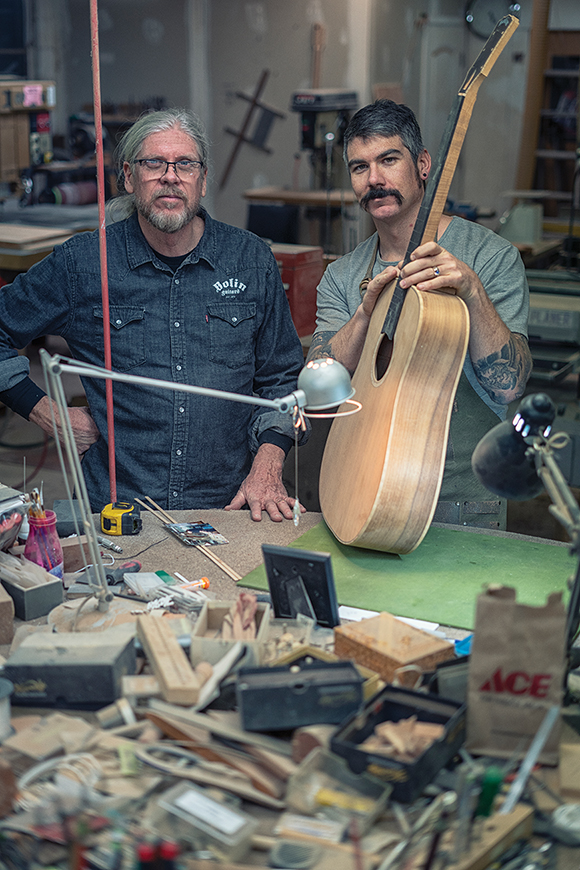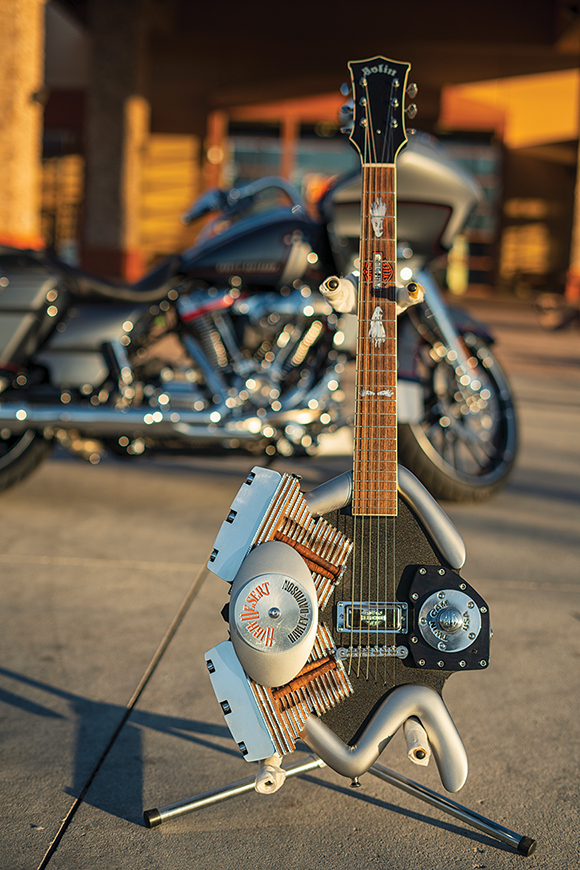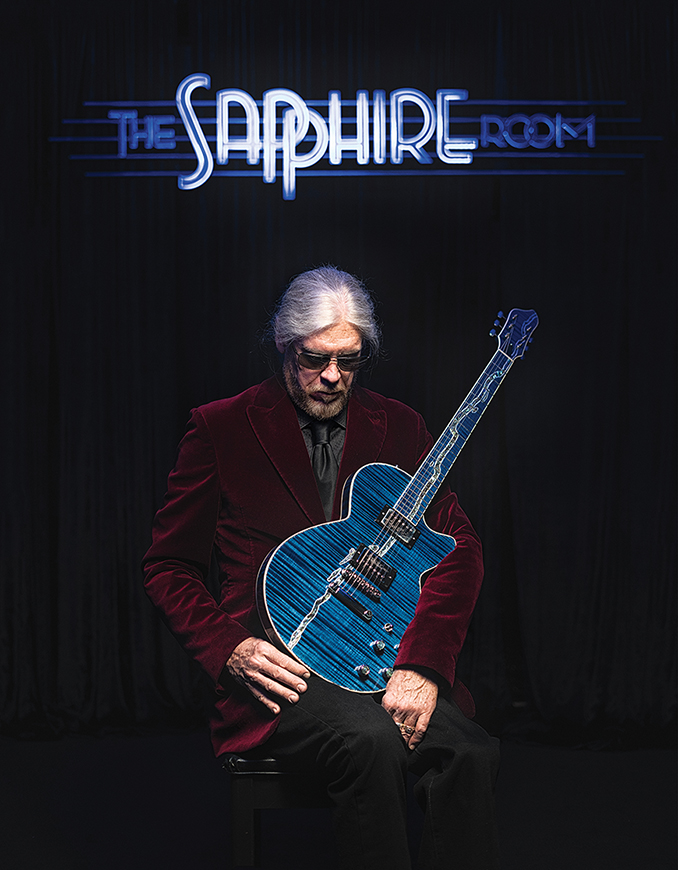Inside an unassuming, flat-roofed building that snugs up against the terrain on Hill Road in Boise, there’s musical alchemy at work. Take innovative and sometimes outrageous ideas for electric guitars that are often sketched on a napkin, add the basics of meticulous, handcrafted detail, the ability to deliver a custom tone, a dash of humor, and a generous dollop of creativity, then, with a swirl of the sorcerer’s wand, blend it all together and, voila: another Bolin guitar with the mojo it takes to command a world-class rock ‘n’ roll stage.
“There’s something magical about what we do,” said John Bolin, a fourth-generation Idahoan. “It’s hard to explain to people, but when they pick up one of our guitars, they go ‘Yeah, this has the mojo! There’s some kind of magic here!’ You take this big chunk of wood, put it through the process, and end up with mojo.”
Bolin’s guitars—works of art in their eclectic beauty and playability—have made him a celebrity in the world of custom guitars. Bolin counts Billy Gibbons, guitarist and lead vocalist of ZZ Top, and adopted Idahoan Steve Miller as friends, clients, and collaborators in design. Last summer, Miller surprised Peter Frampton with a Bolin guitar, his first, when they both headlined at the Idaho Botanical Garden’s Outlaw Field. Bolin’s shop has crafted guitars for clients as diverse as Brent Hinds of Mastodon, Lou Reed, Doc Watson, bluesman Albert King, Joe Perry of Aerosmith, Keith Richards, and Jimmy Page.
“Over the years, John and a small team, including his son Jake, have built some of the most innovative and visually distinctive guitars in rock and roll history,” writes Robert Shaw in his book “Electrified,” which features some of the industry’s best guitar makers.
Bolin said one of his strengths is the ability to think “way outside the box,” a skill that serves him well in his design collaboration with Gibbons. “Billy is an absolute genius in the design area,” said Bolin.

John and Jake Bolin in their work studio. Photo by Todd Meier
In Gibbons’ book, “Rock + Roll Gearhead,” Bolin explains that Gibbons has “a great sense of design and style that constantly stretches the boundaries for me as a guitar builder. His eye for detail is astounding.”
Of course, Bolin is no slouch himself. There is a hand-scrawled message above the door to his studio that reads: “Can’t is not spoken here!” No matter what wild ideas he and Gibbons dream up, Bolin and his team figure out a way to make it happen.
Take the neon guitars, for instance. Gibbons wanted a matching pair of guitars with working neon to light up ZZ Top’s “Viva Las Vegas” video, promoting the album of the same name. “It took a team of people to think through this and shout-out to sign maker Noel Weber,” said Bolin. “Guitars don’t like neon because the lights buzz and our original power source was half the size of the guitar … so we had to find a neon glassmaker and figure out how to get the neon hot and bend it and how to put it on the guitar. It was a crazy process—completely challenging—because no one had ever done it before!” They ended up creating two see-through instruments where the neon tubing was incorporated inside the guitars, following the shape of the body, including up the fingerboard and headstock.
In the early 2000s, Bolin was in a wheelchair, recovering from a horrible motorcycle accident. The shop staff was busy, business was humming, and he felt himself at loose ends. “I had an aluminum Telecaster–style guitar body and I had this crazy idea that I would make Keith Richards a guitar,” recounted Bolin. “I got 75 percent of it built when Billy called to see how I was doing. I told him I was building Keith Richards a guitar—I didn’t draw anything, I was just building it—and Billy tells me to paint the guitar fuchsia pink, Keith will love it, and to do a silver inlay of the name Blues Basher with a dripping font (on the fingerboard). I called Mike Flinn to do the art, and he goes through the roof because he’s a huge Keith Richards fan.”
“When John Bolin calls, I drop everything because the work is so interesting,” said Flinn, a well-known editorial cartoonist and commercial artist based in Boise. “I can’t say how much this relationship has meant to me. John is that rare guy you can work back and forth with—a straight shooter. He’ll call me up and say, ‘I’ve got this guitar I’m working on for Jeff Beck’… It floors me, working for some of the biggest names in rock ‘n’ roll!”
But back to the Blues Basher: “We’re 99 percent done when Billy calls me and says the Stones are playing the Houston Astrodome in two days and can I FedEx the guitar to him,” recalled Bolin. “He and his mother went to the show and gave it to Pierre de Beauport, Keith’s main guitar tech. Pierre looks at it and says, ‘Wow, what is this?’ Billy tells him he’d played it and it was really hard to give up. So Pierre shows it to Keith and puts it in his guitar rack. Keith asked if Billy had played it, Pierre says yes and after that it became the guitar Keith played on ‘Satisfaction’ every night for the rest of the ‘Forty Licks’ tour.“
In his memoir “Life,” Richards describes the synchronicity he and guitarist Ronnie Wood create playing together. So, shortly after Richards received his Blues Basher, Gibbons called Bolin again to say that “Ronnie felt left out” and commissioned a Stratocaster-style aluminum guitar for Wood, both instrument and musician affectionately known as Woody. “I’m very proud of the fact and honored that I was able to make those two men guitars,” said Bolin. “I grew up to the Rolling Stones—they were my go-to band—and I’ve got the vinyl to prove it!”

The “Twin Cam” guitar that Bolin created for Bob and Dave Thomas of High Desert Harley-Davidson. Photo by Todd Meier.
The studio at Bolin Guitars has been turning out guitars that are not only unique but sometimes improbable, such as the “Twin Cam” guitar he made for Bob and Dave Thomas of High Desert Harley-Davidson in Boise. The guitar features “tailpipes,” cylinders crafted of aluminum and rosewood, and the Harley-Davidson eagle logo hand cut and inlaid in the fingerboard. Push a button on the body and you’ll hear the sound of a Harley revving!
Bolin’s attention to detail is just one element that differentiates Bolin Guitars from other custom luthiers. Understanding the vision in the client’s head and translating that to a guitar that captures the look and sound the client dreams of is a skill that verges on the, well, magical.
“A guitar is nothing but details, literally hundreds of details,” explained Bolin. “My clients call me with a wish list, and we build their dream guitar. The real gift I have is being able to talk with someone and come up with a design they approve of and then build a guitar they love. Once we’ve settled on the body and the headstock shape, we’ll go to the print shop and have copies made, then start cutting sheets of paper and transfer that to a wooden template that goes through the machinery to create a guitar.”
Bolin stresses that while the tools his team uses are comparable to those you’d find in a cabinet-maker’s shop, the guitars are all hand-finished; nothing in the process is computerized or automated.
Tone is a huge component of good guitar craftsmanship. Experienced musicians often have a sound that is part of their musical identity, and they want a new guitar to replicate that sound. It’s the job of Bolin’s team to ensure that no matter how beautiful or crazy the guitar looks it plays well and produces the tone that the client desires.
Jake Bolin, who apprenticed with his dad and has toured with Steve Miller as his guitar tech, explained: “There’s a scientific aspect to how atmosphere and environment affect sound waves. Each individual musician hears sound differently, so when it comes to crafting sound, our tonal intention is to produce something seriously similar to what they already had. We do this through a process of open communication we’ve developed with the clients. We know the musician, his style of playing and the guitar attached to him. As the relationship deepens, it only gets better.”
All of the different materials used in a guitar body—wood, metal, lacquer, paint—and the way it’s buffed and polished, the way a fretboard is addressed affect the tone the musician is able to coax from the instrument. Softer woods absorb more vibration and produce a resonance and warmer tone. Hard woods such as maple, ebony or rosewood are structurally tighter, and the sound bounces out of the instrument for a punchier, brighter, sharper sound.
Through a technique called “chambering” in which the interior guitar body comprises hollow chambers, Bolin Guitars can be two-thirds the weight of traditional electric guitars. These “enlightened” models, as the Bolins refer to them, make it easier for seasoned musicians to perform live and move easily with the instrument.
One of the guitars Bolin is most proud of hangs in the lobby of The Riverside Hotel. The Riverside, home of the Sapphire Room and the Sandbar music venues, and known for its support of local musicians, was in the midst of a lobby renovation when construction contractor Mark Guho introduced John Bolin to owners Lynda and David Johnson. Bolin, with the help of his team and local artist Bruce Maury, created a guitar of shimmering blue, inlaid with mother of pearl and abalone that evokes the Boise River. “The only instructions we gave John were to use his amazing creativity 100 percent,” said Lynda Johnson. “And it’s just gorgeous! It’s really a work of art. Working with Bolin Guitars was a wonderful experience for all of us.”
The body, which looks like rippling water, is cut from one block of Western big leaf maple. Bolin spent four months searching for just the right piece. He hand cut the abalone “river” inlay and applied a sapphire blue translucent toner over the maple body. Then, after a series of pre-staining and sanding to achieve the ripple effect, he overshot the guitar with another application of translucent stain so the maple underneath was visible.
“People love it, and they love to hear John Bolin created it because he’s well-known in the music industry,” said Johnson. “This guitar reflects music and nature and the river. There’s a magical feeling about it and it’s a reminder of the amazing talent we have here in Boise. John Bolin is the best in the world; there’s no one better than him.”
Typically self-effacing, Bolin is quick to point out that the instruments his studio turns out are a team effort, in particular, with his son Jake. Although Jake has other interests, he comes into the shop as needed, and he and his dad are so attuned to each other’s process, he can pick up wherever his dad leaves off. And luthier Andrew Jones has been working at Bolin Guitars since 1995, that is, when he’s not touring with stars such as Rod Stewart and Taylor Swift.
Bolin gives a grateful recognition to all the local artists and fabricators who have served as resources. He credits his wife Cristi with allowing him to devote his time to his craft by taking care of office operations, and his daughter Celeste, who holds a Ph.D. in neurotoxicology and teaches dance in Boise, as being part of the family effort. Bolin even credits his dog, Queenie, “who has to hear all the bitching from me!”
John and Jake Bolin may be humble, but there’s no denying that they know how to create a sound and energy in a way that defies rational explanation.
“Musicians talk about mojo,” explained Jake, “which is an energy out there that certain people can tap into. At Bolin Guitars, we carry the kinetic energy in our bodies, and as we carve and machine by hand we put our physical energy into the instruments. The musicians feel a level of confidence and trust in their instruments, which then become an extension of their bodies. It’s mojo!”

